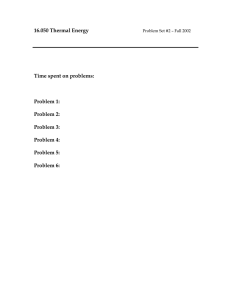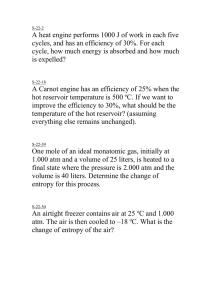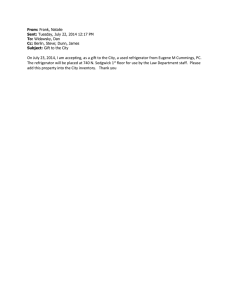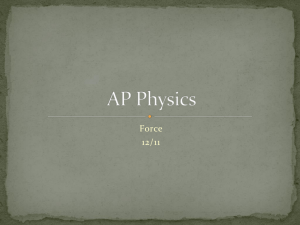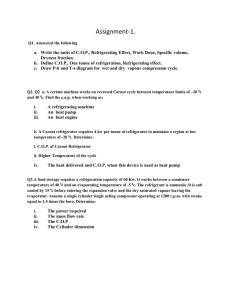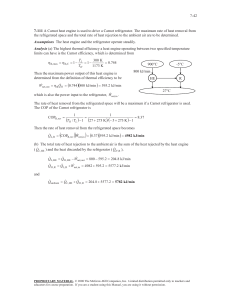4.2 Refrigerators
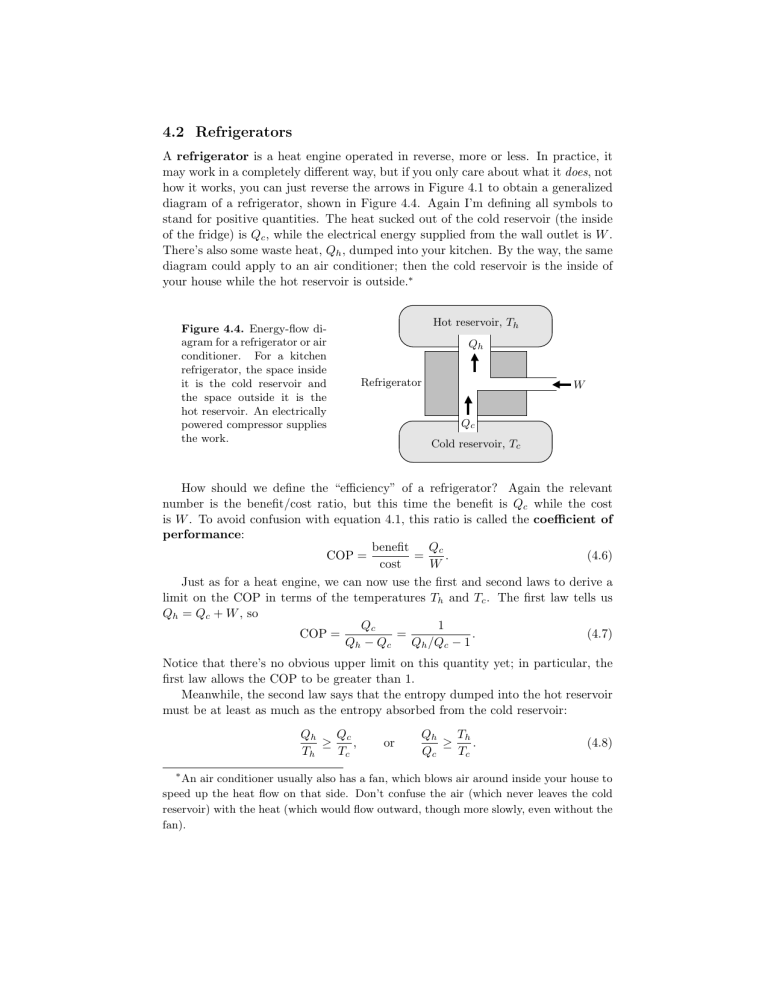
4.2 Refrigerators
A refrigerator is a heat engine operated in reverse, more or less. In practice, it may work in a completely different way, but if you only care about what it does , not how it works, you can just reverse the arrows in Figure 4.1to obtain a generalized diagram of a refrigerator, shown in Figure 4.4. Again I’m defining all symbols to stand for positive quantities. The heat sucked out of the cold reservoir (the inside of the fridge) is Q c
, while the electrical energy supplied from the wall outlet is W .
There’s also some waste heat, Q h
, dumped into your kitchen. By the way, the same diagram could apply to an air conditioner; then the cold reservoir is the inside of your house while the hot reservoir is outside.
∗
Hot reservoir, T h
Q h
Figure 4.4.
Energy-flow diagram for a refrigerator or air conditioner.
For a kitchen refrigerator, the space inside it is the cold reservoir and the space outside it is the hot reservoir. An electrically powered compressor supplies the work.
Refrigerator
Q c
Cold reservoir, T c
W
How should we define the “efficiency” of a refrigerator? Again the relevant number is the benefit/cost ratio, but this time the benefit is Q c while the cost is W . To avoid confusion with equation 4.1, this ratio is called the coefficient of performance :
COP = benefit cost
=
Q c
.
W
(4.6)
Just as for a heat engine, we can now use the first and second laws to derive a limit on the COP in terms of the temperatures T h
Q h
= Q c
+ W , so
COP =
Q h
Q c
− Q c
=
Q h
1
/Q c and T c
. The first law tells us
− 1
.
(4.7)
Notice that there’s no obvious upper limit on this quantity yet; in particular, the first law allows the COP to be greater than 1.
Meanwhile, the second law says that the entropy dumped into the hot reservoir must be at least as much as the entropy absorbed from the cold reservoir:
Q
T h h
≥
Q c
,
T c or
Q h
Q c
≥
T h
.
T c
(4.8)
∗
An air conditioner usually also has a fan, which blows air around inside your house to speed up the heat flow on that side. Don’t confuse the air (which never leaves the cold reservoir) with the heat (which would flow outward, though more slowly, even without the fan).
(This relation is the reverse of relation 4.4 because the entropy is flowing in the opposite direction.) Plugging this inequality into equation 4.7 gives
COP ≤
1
T h
/T c
−
1
=
T h
T c
−
T c
.
(4.9)
For a typical kitchen refrigerator (with freezer), T h might be 298 K while T c might be 255 K. In this case the coefficient of performance can be as high as 5.9. In other words, for each joule of electrical energy drawn from the wall, the coolant can suck as much as 5.9 J of heat from the inside of the refrigerator/freezer. In this ideal case, the waste heat dumped into the kitchen would be 6.9 J. As you can see from the formula, the COP is largest when T h and T c aren’t very different. A refrigerator that cools something down to liquid helium temperature (4 K) would have to be much less efficient.
To make an ideal refrigerator with the maximum possible COP, one can again use a Carnot cycle, this time operated in reverse. In order to make the heat flow in the opposite direction, the working substance must be slightly hotter than T h heat is being expelled, and slightly colder than T c while while heat is being absorbed.
Once again, this is a lousy way to do things in practice, because the heat transfer is much too slow. A more practical refrigerator is described in Section 4.4.
Historically, heat engines and refrigerators played a crucial role in the formulation of the second law and the identification of entropy as a quantity of interest.
Early versions of the second law, derived from experience, included the statements that all heat engines must produce some waste heat, and that all refrigerators require some work input. Carnot and others invented ingenious arguments to show that these laws could be violated if you could make an engine or a refrigerator whose efficiency exceeded that of a Carnot cycle (see Problems 4.16 and 4.17). Carnot also recognized that for an ideal engine there must be a quantity, associated with heat, that flows in from the hot reservoir and out to the cold reservoir in equal amounts. But Carnot’s 1824 memoir did not distinguish carefully enough between this quantity and what we now call simply “heat.” At that time the relation between heat and other forms of energy was still controversial, and the simple formula
Q/T eluded scientists who had not yet adopted a temperature scale measured from absolute zero. It wasn’t until 1865, after these other issues were fully resolved, that
Rudolf Clausius brought Carnot’s quantity to the full attention of the scientific community and put it on a firm mathematical basis. He coined the term “entropy” for this quantity, after a Greek word meaning “transformation” (and because the word resembles “energy”). Clausius did not explain what entropy actually is , however. Ludwig Boltzmann took up that question during the following years, and had it figured out by 1877.
